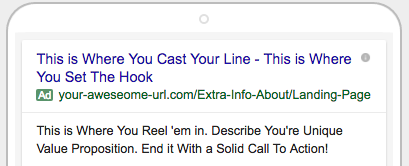Google released Expanded Text Ads (ETAs) in July of this year. ETAs will soon be the standard text ad format, so it’s important to get ahead of the curve and start implementing ETAs now.
One Advantage of ETAs are that they allow you to add more text than before. This means you can be even more descriptive about your business and more relevant to users’ search queries. In addition, ETAs are optimized for mobile devices, which is becoming more and more important in today’s online world.
There are noticeable performance improvements after implementing expanded text ads. In particular, increased Click-Through-Rates (CTR) and overall Quality Score. Google seemingly rewards advertisers who adopt expanded text ads.
This quick overview will show you how to create expanded text ads for success. We’ll break down each of the 3 main component of an expanded text ad – Headlines, Description and Path Fields. Here’s a screenshot of an ETA in layman’s terms:

Let’s go over each component in more detail.
#1: Headlines – Cast Your Line and Set the Hook
Headlines are the first thing people look at when they see an ad on Google. Headlines should catch the attention of your audience. The goal of headlines are to make users want to learn more by reading the rest of your ad and eventually clicking on it.
ETAs have two headlines separated by a hyphen, like this:

Each headline has a 30-character limit. Be sure to put thought into each headline. Make sure headlines 1 and 2 complement each other and make sense together.
The last thing you want to do is carelessly add a second headline to your already existing text ads. Google doesn’t like that and neither will your audience.
#2: Description – Reel ‘em in by Describing Why You Are the Best
The description is where you give your unique value proposition. Your description should help answer the following questions:
- What makes your business unique?
- Why are you the best at what you do?
- What does your business offer that others do not?
To achieve complete success with your expanded text ad’s description, be sure to include a clear Call-to-Action such as, “Buy Now,” “Call Today” or “Book a Reservation.” This helps guide the user towards a desired action. The easier you make the customer journey, the better.
You get up to 80 characters in the description, so be concise and to the point.
#3: Path Fields – Extra Information About Your Landing Page
Path fields are optional, yet important, snippets of text added to the end of your Display URL – the URL that is shown in your ad. Expanded text ads contain two path fields separated with a forward slash ( / ).
Path fields should be used to further describe what users will find on the landing page once they click on you ad. If your landing page, for example, is promoting a new line of organic coffee beans, then you might make path 1 = Organic and path 2 = Coffee_Beans. Your resulting Display URL would look something like this:

Each path field has a 15-character limit. Remember, character limits are just that: limits. You don’t necessarily need to reach the limit. The most important thing is to be relevant to the user’s search query, even if that means being well under the character limit. Keyword-stuffing and/or adding extra keywords just to fill space is so 1998 – please refrain from doing so for the Internet’s sake.
Conclusion
Expanded Text Ads (ETAs) are the future of text advertising and they perform noticeably better than traditional text ads in most cases. It’s best to start implementing ETAs as soon as possible if you haven’t already. ETAs consist of two headlines, a description and two path fields. Thoughtfully crafting each component of expanded text ads will result in increased ad performance and overall success in your AdWords campaigns.
